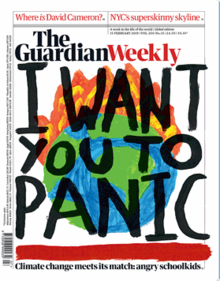History
Early years
The first edition of the Manchester Guardian Weekly was printed on 4 July 1919, [4] a week after the signing of the Treaty of Versailles. The Manchester Guardian viewed itself as a leading liberal voice and wanted to extend its reach, particularly in the United States, in the changing political climate after the First World War. The Weekly had the stated aim of "presenting what is best and most interesting in the Manchester Guardian, what is most distinctive and independent of time, in a compact weekly form". [1] The initial reception was good. Before long the Manchester Guardian could boast "there is scarcely a corner of the civilised world to which it is not being posted regularly", although it is worth noting that the newspaper was banned in Germany by Hitler [5] for a time.
Evolution and editorship 1969-2007
For a large part of its early life the newspaper was a half-broadsheet format. Initially the notion of ‘the best of the Guardian’ meant a weighty opinion piece for the front page. It evolved, under the editorship of John Perkin, [6] in 1969, to include the use of pictures on the front page.
In 1971, the English edition of the French daily newspaper Le Monde folded and the Weekly took on its 12,000-strong subscription list as well as four pages of Le Monde copy. A content deal was made with The Washington Post in 1975. Dedicated pages from both publications augmented Guardian articles until a redesign in 1993, under new editor Patrick Ensor, led to their articles appearing across the Weekly. In the same year, content from The Observer [2] began to appear after the UK Sunday title was purchased by Guardian Media Group. [7]
Around this time the Weekly relocated from Cheadle, to the south of Manchester, to join the rest of the Guardian in London. [8] This move afforded the Weekly better access to editors, leader writers and news features. In 1991, technological advances enabled the first transmission by modem of pages to an Australian print site. Under Ensor's editorship, the paper began to be produced using the desktop publishing program Quark XPress. It became a tabloid-sized publication; then, in 2005, when the daily Guardian newspaper converted from a broadsheet to the smaller, Berliner format, [9] the Guardian Weekly shrank to a half-Berliner while increasing pagination to its now-standard 48 pages. Full-colour printing was also introduced. By the end of Ensor's editorship, curtailed by his death from cancer in 2007, [10] more advances in technology meant that even Weekly readers in the most remote locations were able to access the internet.
Since 2007
The appointment of Australian Natalie Bennett [11] as Ensor's successor coincided with the Guardian’s move to a digital-first publishing strategy. Breaking news stories were now launched on the Guardian's fast-growing website, rather than held back to meet print deadlines. In 2007 a digital edition [12] of the Guardian Weekly was created, an editor's blog [13] was added and a presence on social media sites Facebook [14] and Twitter [15] came soon after. The Guardian Weekly can be found online at theguardian.com/weekly, where subscription information is also available. During her editorship, Bennett emphasised the need for the Weekly’s agenda to be truly global and increased its coverage of environmental issues and the developing world. Her passion for environmental politics led to her departure from the paper in 2012. She would go on to become the leader of the Green Party of England and Wales until 2016. [16]
The Guardian Weekly’s evolution continued under Abby Deveney, [17] a newspaper, newswire and web editor with more than three decades of international experience living and working in North America, Asia and Europe. Under Canadian Deveney, the Weekly embraced long-form journalism, with a greater emphasis on insightful writing, deep analysis and lively features that showcase a well-rounded world view. Reportage of global themes and trends now features on the front page, while the back page is a stage for the Guardian’s influential opinion writers. Her global experience ensures that the Weekly never comes from one geographical perspective. This aim has been aided by the launch in 2011 of a Guardian US website, edited from New York City, followed two years later by a Sydney-based Guardian Australia site, which greatly increased the Weekly’s coverage opportunities in these key territories. Deveney left the editorship in 2017 and was eventually replaced by Will Dean in April 2018.
The Guardian Weekly was re-designed in October 2018 as a glossy magazine. [18] It was announced that the circulation of the magazine would increase, and three different editions would be published: International, North American, and Australian. [19]
Worldwide readership
Britain, Australia, the United States and Canada are the Guardian Weekly’s top markets, followed by New Zealand, France and Germany. With a following in more than 170 countries, [1] the Weekly’s audience is spread around the world. [20]
Surveys reveal that some 60% of subscribers had taken the paper for more than a decade. Readership tends towards a well-educated demographic. The typical reader is aged over 45, educated to at least degree level and either working in or retired from education, with a 59-41 male-female split. [1]
Readers say typical reasons for subscribing include: a family habit of taking the Manchester Guardian; a spell working abroad in development or teaching; and retirement or emigration (often to Australia, New Zealand or North America). Others often report their route to initiation into the Guardian Weekly family came by having a copy passed along to them in a workplace or during a secondment.

The Times is a British daily national newspaper based in London. It began in 1785 under the title The Daily Universal Register, adopting its modern name on 1 January 1788. The Times and its sister paper The Sunday Times are published by Times Media, since 1981 a subsidiary of News UK, in turn wholly owned by News Corp. The Times and The Sunday Times, which do not share editorial staff, were founded independently and have had common ownership only since 1966. In general, the political position of The Times is considered to be centre-right.
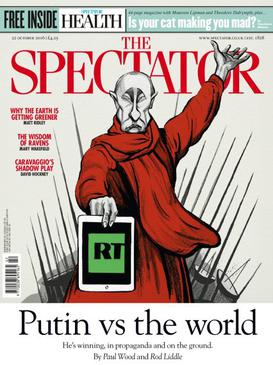
The Spectator is a weekly British news magazine focusing on politics, culture, and current affairs. It was first published in July 1828, making it the oldest surviving weekly magazine in the world. The Spectator is politically conservative, and its principal subject areas are politics and culture. Alongside columns and features on current affairs, the magazine also contains arts pages on books, music, opera, film, and TV reviews. In 2021, it had an average circulation of 102,212.
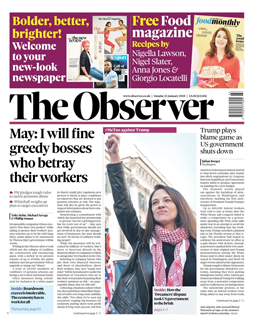
The Observer is a British newspaper published on Sundays. It is a sister paper to The Guardian and The Guardian Weekly, having been acquired by their parent company, Guardian Media Group Limited, in 1993. First published in 1791, it is the world's oldest Sunday newspaper.

The Daily Star is a tabloid newspaper published from Monday to Saturday in the United Kingdom since 1978. In 2002, a sister Sunday edition, Daily Star Sunday was launched with a separate staff. In 2009, the Daily Star published its 10,000th issue. Jon Clark is the editor-in-chief of the paper.

Metro is the United Kingdom's highest-circulation freesheet tabloid newspaper. It is published in tabloid format by DMG Media. The newspaper is distributed from Monday to Friday mornings on public places in areas of England, Wales and Scotland. Copies are also handed out to pedestrians.
The Scott Trust Limited is the British company that owns Guardian Media Group and thus The Guardian and The Observer as well as various other media businesses in the UK. In 2008, it replaced the Scott Trust, which had owned The Guardian since 1936.

The Manchester Evening News (MEN) is a regional daily newspaper covering Greater Manchester in North West England, founded in 1868. It is published Monday–Saturday; a Sunday edition, the MEN on Sunday, was launched in February 2019. The newspaper is owned by Reach plc ,[2] one of Britain's largest newspaper publishing groups.
The Nestlé Children's Book Prize, and Nestlé Smarties Book Prize for a time, was a set of annual awards for British children's books that ran from 1985 to 2007. It was administered by BookTrust, an independent charity that promotes books and reading in the United Kingdom, and sponsored by Nestlé, the manufacturer of Smarties candy. It was one of the most respected and prestigious prizes for children's literature.
Peter John Preston was a British journalist and author. He was editor of The Guardian for twenty years, from 1975 to 1995.
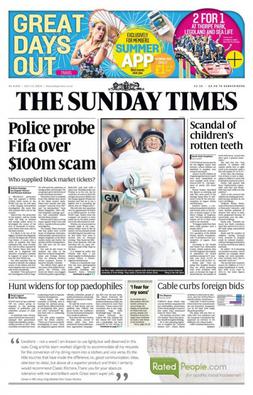
The Sunday Times is a British Sunday newspaper whose circulation makes it the largest in Britain's quality press market category. It was founded in 1821 as The New Observer. It is published by Times Newspapers Ltd, a subsidiary of News UK, which is owned by News Corp. Times Newspapers also publishes The Times. The two papers, founded separately and independently, have been under the same ownership since 1966. They were bought by News International in 1981.

Messenger Newspapers is the publisher of 9 free suburban weekly newspapers together covering the Adelaide metropolitan area. Established by Roger Baynes in Port Adelaide in 1951, Messenger has since acquired other independent suburban titles to become Adelaide's only suburban newspaper group. The paper is a subsidiary of News Limited and is affiliated with The Adelaide Advertiser. The Messenger is delivered weekly to 9 different suburban areas, each paper targeting content to its distribution area with some shared content.
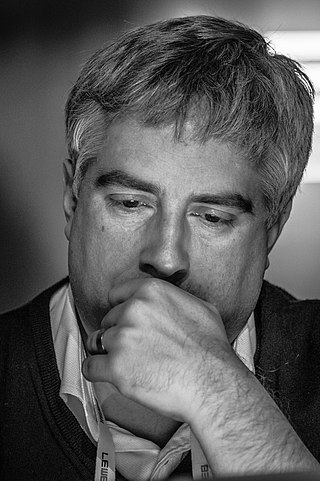
Adam Matthew J. Tinworth is a journalist and writer who co-authored two major role-playing games, Demon: The Fallen and Werewolf: The Forsaken from White Wolf Publishing. He was also an extensive contributor to Hunter: The Reckoning, a game line that was subsequently ported to video games.

The Catholic Herald is a London-based Roman Catholic monthly magazine, founded in 1888 and a sister organisation to the non-profit Catholic Herald Institute, based in New York. After 126 years as a weekly newspaper, it became a magazine in 2014. In early 2023, a 50.1% controlling stake was purchased by New York based alternative asset firm GEM Global Yield LLC SCS (Luxembourg). It reports 565,000 online readers a month, along with 30,100 weekly registered newsletter subscribers and a print readership distributed in the US and UK, Roman Catholic parishes, wholesale outlets, the Vatican, Cardinals, Catholic influencers, and postal/digital subscribers.

The Guardian is a British daily newspaper. It was founded in 1821 as The Manchester Guardian, before it changed its name in 1959. Along with its sister papers, The Observer and The Guardian Weekly, The Guardian is part of the Guardian Media Group, owned by the Scott Trust Limited. The trust was created in 1936 to "secure the financial and editorial independence of The Guardian in perpetuity and to safeguard the journalistic freedom and liberal values of The Guardian free from commercial or political interference". The trust was converted into a limited company in 2008, with a constitution written so as to maintain for The Guardian the same protections as were built into the structure of the Scott Trust by its creators. Profits are reinvested in its journalism rather than distributed to owners or shareholders. It is considered a newspaper of record in the UK.
The NewsMail is an online newspaper based in Bundaberg, Queensland, Australia. It has a wide range of content including domestic and international affairs. The paper has a long, notable history, starting as a family business and more recently becoming part of the regional network of News Corp Australia, the largest Australian newspaper publisher. It shut down its printed edition and became online-only in June 2020.

York Vision is one of two student newspapers at the University of York. Vision is a registered society of, and is funded by the University of York Students' Union (YUSU).
Dennis Hackett was a British magazine and newspaper editor whom many would say played significant roles on game-changing publications that reshaped the language of British journalism.
Richard Walsh is an Australian publisher, editor, company director, media consultant, lecturer, broadcaster and journalist. For many years he ran the publishing and bookselling firm Angus & Robertson and later he headed the media company Australian Consolidated Press. In those roles he was "one of the most dominant figures in Australian publishing from the early seventies".
Alison Phillips is a British journalist who served as the editor of the Daily Mirror between 2018 and 2024.

Co-op News is a UK-based monthly news magazine and website for the global co-operative movement.
